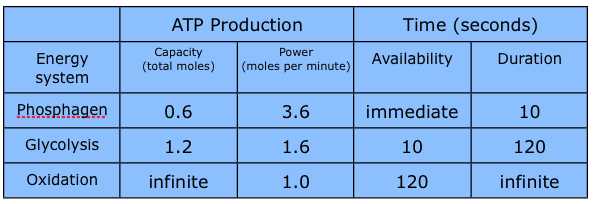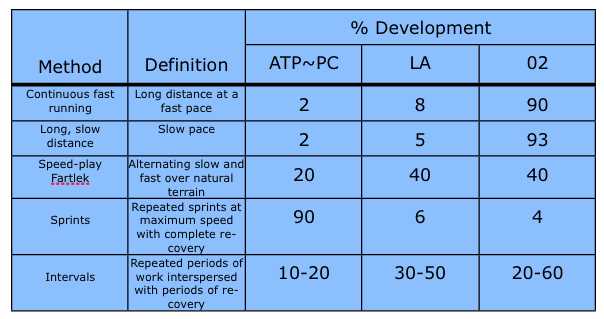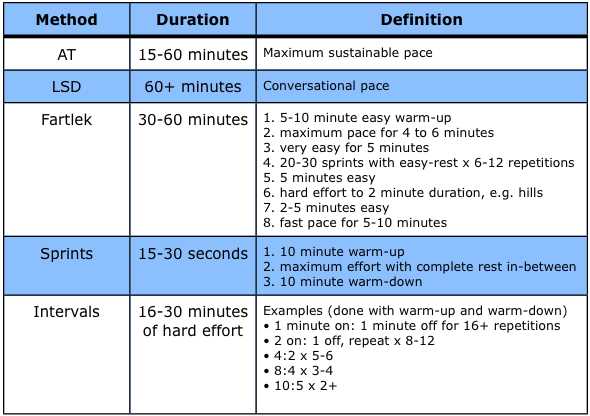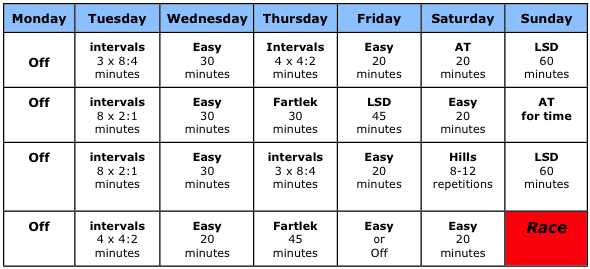Energy Supply
Each athletic endeavor has specific movements performed with a certain intensity over the time frame of the activity. Performance is determined by the efficiency or precision of the movement as provided by the appropriate muscle groups, the strength of those muscles and their endurance. To maximize the benefits of any training program, it must be designed to develop the specific physiologic parameters by the intended sports skill or activity. Every sport has a unique metabolic profile.
All metabolic processes in the body require energy liberated by the breakdown of high energy phosphate bonds. Most of this occurs in the form of adenosine triphosphate or ATP:
In the working muscles ATP comes through three metabolic processes:
- Phosphagen– ATP and creatine phosphate (CP) which is stored in the muscle tissue as ATP~CP.
- Glycolysis– ATP that results when sugar, specifically glucose, is broken down into lactic acid.
- Oxidative phosphorylation– ATP generated from the more complete combustion of glucose in the presence of oxygen.
The first two processes are accomplished without oxygen (anaerobic metabolism), while the third is called aerobic. The metabolic profile of each activity is determined by the total amount of energy required, and the rate that energy is demanded by the muscles. For example, sprinting 100 meters, or rushing the passer do not require much total energy (0.43 moles of ATP) because of their short time-frame, but demand very high rate of energy utilization (2.6 moles per minute).
Doing the same analysis, a marathon race requires much lower power output (less than 1 mole per minute), but due to its duration, an immense total energy requirement (over 150 moles of ATP). The body is able to make these adjustments because the three energy systems differ in their capacity, power and timing:
Some important points:
- The time each system is being used is not mutually exclusive, that is, all systems begin at the start of work and may be in use for a greater period of time depending on the economy and efficiency of effort.
- Phosphagen stores are used up very quickly at maximum effort.
- The end product of glycolysis is lactic acid, and every athlete can attest to the work-limiting burn of its accumulation.
- The importance of warm-up can be understood when you realize that oxidation kicks-in around two minutes.
- Oxidative capacity (the ability to use oxygen) can be considered infinite–limited only by food supply and fatigue.
Using your knowledge
With this information we can begin to determine the metabolic profiles of specific sports.
Activities that require short bursts of maximum muscle effort mainly rely on phosphagen stored in the muscles: weight lifting, short sprints, shot put, football line play, etc.
Activities that require bursts of effort for less than two minutes, including those within the framework of longer duration rely on anaerobic glycolysis: shift in a hockey game, hills in a long run, cross country skiing or bicycling, 400 to 800 meter run, shorter events in speed skating, volley in tennis match, etc.
Aerobic metabolism provides the energy necessary to replenish the spent anaerobic stores, as well as for most activities over four minutes in effort.
The metabolic profile is important to formulating a sports-specific training program. Because each energy process must be trained in a specific way, with knowledge of the energy systems involved, it is possible to design your program to best develop the processes required.
Using information originally developed for the training of track athletes we can begin to design appropriate workouts:
Note the variation in energy system development available with interval training:
- By increasing the intensity of effort with a corresponding decrease in interval length, and allowing near maximal recovery between efforts, the energy source becomes more anaerobic.
- An increase in interval length demands a greater percentage of aerobic energy.
- By keeping the recovery period short, lactic acid levels remain high in the exercising muscles. This forces the aerobic system to work harder and become more efficient in breaking down lactic acid. This is a very important adaptation necessary in longer duration, high-power activities.
Continuous hard training requires maximum aerobic power, and can dip into anaerobic energy sources. The point this occurs is called the anaerobic threshold (AT). Ultimately this becomes the limitation of aerobic fitness– how hard you can work before you need to use too much anaerobic energy. Every athlete has gone out too fast: you can’t get enough oxygen, and your muscles burn too much to continue at the present pace. AT training is paramount to improving aerobic power. This will be addressed in part 2.
To apply these workouts to a wider range of activities, it is easier to use time-frames instead of distance:
These workouts should form the core of any aerobic training program.
Unfortunately due to the high intensity level when these are added to a program there is an increased chance for injury and burn-out. Therefore, it’s necessary to place these workouts within a framework of rest. It’s recommended that you begin with two or three hard training sessions per week.
Gradually increase the volume (duration and number of repetitions) and intensity of hard work, keeping in mind that performance is only improved through consistent training. It’s wiser to rest or decrease workout intensity than risk a nagging injury that prevents training completely.
Example of a 4 week training cycle
Some notes on the training cycle:
- It can be broken down into weekly, biweekly, bimonthly, etc.
- No more than two interval sessions per week.
- If prepared, fartlek sessions can be extended up to 60+ minutes.
- Include weekly (except 3rd) AT training which is performed at maximum sustainable pace.
- This prepares you to race, and in this example, a race comes at the end of the month.
- A hill session could be substituted for Tuesday’s short interval workout in the 2nd week.
- Hills are a muscle power workout and should require 60-120 seconds hard effort.
- The race length is presumed to be 5K up to 5 miles (15-30 minutes).
- A 10K race should probably have longer easy runs (~45 minutes) and longer AT runs (30-45 minutes).
- To add more interval work will inevitably lead to injury.
- Remember the adage: speed kills!







